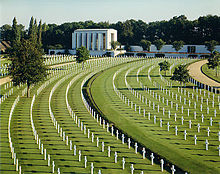Madingley
| Madingley | |
|---|---|
| Population | 206 (2001) |
| OS grid reference | TL395605 |
| District | |
| Shire county | |
| Region | |
| Country | England |
| Sovereign state | United Kingdom |
| Post town | CAMBRIDGE |
| Postcode district | CB23 |
| Dialling code | 01954 |
| Police | Cambridgeshire |
| Fire | Cambridgeshire |
| Ambulance | East of England |
| UK Parliament | |
Madingley is a village near Coton and Dry Drayton on the western outskirts of Cambridge in the United Kingdom. Known as Madingelei in the Domesday Book, the village's name means "Woodland clearing of the family or followers of a man called Mada".[1]
Madingley Hall

The village is home to Madingley Hall, which was built by Sir John Hynde in 1543 and occupied as a residence by his descendants until the 1860s. It is surrounded by parkland. Queen Victoria rented the Hall in 1860 for her son Edward (the future King Edward VII) to live in while he was an undergraduate at Cambridge University. The family sold the Hall in 1871.[2]
The lake in the grounds is home to a variety of wildlife. The rare black squirrel has been spotted in the area and even red kites have been mentioned as being spotted by locals.
The Hall and its surrounding park and farmland have been owned by the University of Cambridge since 1948 and is currently the home of the Institute of Continuing Education.
Cambridge American Cemetery and Memorial

The Cambridge American Cemetery and Memorial is a cemetery and chapel dedicated to American servicemen opened in 1956, on the southern edge of the village beside the road from Cambridge to St Neots. The 30½ acres were donated by the University of Cambridge.
3812 American military dead are buried in the cemetery. In addition, the names of 5127 are inscribed on the Wall of the Missing, Americans who lost their lives but whose remains were never recovered or identified. Most of these died in the Battle of the Atlantic (1939-1945) or in the strategic air bombardment of Northwest Europe during World War II.[3]
Village life
The village's former public house, The Three Horseshoes, is now a restaurant though it still has a bar that serves beer. The village has an independent pre-preparatory school which caters for reception to year-two students. The village's community spirit is exemplified by the yearly quiz. There is also a village church, which takes services weekly. The church has a 12th-century canonical sundial on the south wall.
The village has two cricket teams, both playing in the Cambridgeshire Cricket Association leagues and one cricket team playing in the Cambridge Business House Midweek League.
See also
- Madingley Road, an arterial road running from Madingley to central Cambridge
- MadingleyParish.net, community website for Madingley
References
- ^ A. D. Mills (2003). A Dictionary of British Place-Names.
- ^ "Institute of Continuing Education: Madingley Hall". University of Cambridge Institute of Continuing Education. 2006. Retrieved 2006-12-31.
- ^ "Cambridge American Cemetery and Memorial". American Battle Monuments Commission. 2005. Retrieved 2006-12-31.



